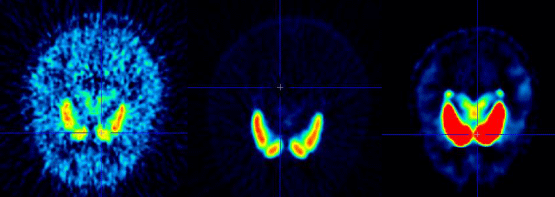Neuroscience Research
Positron Emission Tomography (PET) allows for the measurement of populations of neurotransmitter receptors and regulators of neurotransmission (transporters which uptake neurotransmitters after their release) in human participants. Using Fallypride PET to image D2/3 dopamine receptor and PE2I PET to image dopamine transporter populations across the human brain, work in the Zald Affective Neuroscience Lab (PI: David Zald, PhD) seeks to understand the role of brain dopamine in subjective valuation, motivation, reward, and decision making. Pharmacological challenges that induce dopamine release (d-amphetamine administration) can be used to measure how the Fallypride PET signal changes differentially across individuals; this metric assists us in understanding the role of dopamine signaling in human behavior.
Combining PET data with functional magnetic resonance imaging (fMRI) of human participants while they perform behavioral tasks allows for a more complete understanding of the neurobiology of decision making behavior and the role of the dopamine system in it.
Combining PET data with functional magnetic resonance imaging (fMRI) of human participants while they perform behavioral tasks allows for a more complete understanding of the neurobiology of decision making behavior and the role of the dopamine system in it.
Fallypride pet as a tool to study the dopamine system in humans
An early (left image) and late (middle) Fallypride PET image displaying the accumulation of the tracer in the striatum (hot colors) with time. From this raw data, we can create binding potential (BP) maps of D2/3 receptor availability across the brain (right image). Looking at differences in these BP measures at baseline and after acute amphetamine (which induces DA release and normally decreases the Fallypride signal) gives us insight into the role of the dopamine system in a variety of human behaviors (personality, choice, addiction risk, etc....).
Research Projects
|
Drug High, Like, and Feel ratings vary across individuals.
Timing of the peak in these effects vary. What explains these individual differences? |
Individual differences in subjective responses to dAMPH.
We have data from our lab here at Vanderbilt and via our collaborators Harriet de Wit at the University of Chicago and Abraham Palmer at the University of California, San Diego that healthy, young adults vary in the degree of self-reported “Feel”, “High”, and “Liking” they report after oral d-amphetamie (dAMPH) versus placebo. The timing of peak subjective Feel/High/Liking, when present, varies across individuals. We are currently studying whether variability in dopamine signaling as assessed with 18F-Fallypride PET before and after dAMPH administration can explain these individual differences in self-report subjective effects. This work has implications for identifying biological markers of potential psychostimulant addiction risk as the speed of delivery of drugs of abuse (and associated fast onset in their effects) are linked to risk for developing dependence. In addition to PET, we plan to assess whether variability in personality traits and genetic markers are associated with the differences we observe in our PET and subjective effect measures. |
|
COMT
DAT1 DRD2 Taq1A Effects on DRD2/3 receptor availability, DAT levels, or dAMPH-induced DA release? |
Impact of commonly studied dopamine genetic polymorphisms on Fallypride PET signal(s).
While many researchers have used genetic variants in dopamine signaling-related genes (DRD2, DAT, COMT, etc…) as proxy measures of dopamine signaling, the impact of genetic variation on dopamine PET signal has been limited by the expense of obtaining sufficient power in PET studies. Here in the Affective Neuroscience lab at Vanderbilt, we are in a unique position to investigate the role of these dopamine signaling genes on baseline DRD2/3 binding potential (assessed with Fallypride) and dAMPH-induced DA release in samples of >150 and ~45 (with another ~50 planned to be collected), respectively. Combining this data with a to-be-collected PET measure of baseline DAT levels will allow us a more complete understanding of if and where genetic variation impacts dopamine signaling. This work will be instrumental in demonstrating the neurobiological and mechanistic specificity (if any) at which these often-studied genetic variants act and potentially identify other variants as good markers of putative dopamine signaling. As genetic tools are becoming more widely used and cost-effective, this work will identify potentially useful tools for assessing dopamine signaling variation in a wide range of settings. |
|
Role of sex hormones on dopamine signaling.
While preclinical and some human work suggests that the female hormones estradiol and progesterone modulate affective processing, working memory, and mesocorticolimbic dopamine signaling, to our knowledge no work has focused on whether these hormones affect dAMPH-induced dopamine release. We plan to investigate sex and sex hormone effects on this measure (indexed by Fallypride displacement after oral dAMPH versus placebo). This work has the potential to allow us to understand variability across sexes and within females that may relate to differential rates of drug addiction and relapse. Furthermore, enzymatic activity of COMT (a critical regulator of cortical dopamine) varies across the sexes. We are also investigating sex x COMT effects on fMRI measures of brain function during task and rest. |
CV
| Chris_Smith_CV_May_2021.pdf | |
| File Size: | 910 kb |
| File Type: | |
Collaborations: Projects, Papers, & People
Polygenic Risk Scores of Psychiatric Disorders: Role of General Factor of Psychopathology
Dopamine D2/3 Receptor Availability and Aging
Dopamine and the Discounting of Time, Effort, and Probability
Role of Dopamine in Impulsive and Compulsive Behaviors in Parkinson's Disease Patients on Dopamine Agonists
Partial Volume Correction in FLB 457 and Fallypride PET Data
Individual Differences in Subjective Responses to d-amphetamine
Genetics and Epigenetics of Dopamine Related Genes
FMT PET (Dopamine Synthesis Measure)
Delay Discounting Task in FMT PET Subjects




















